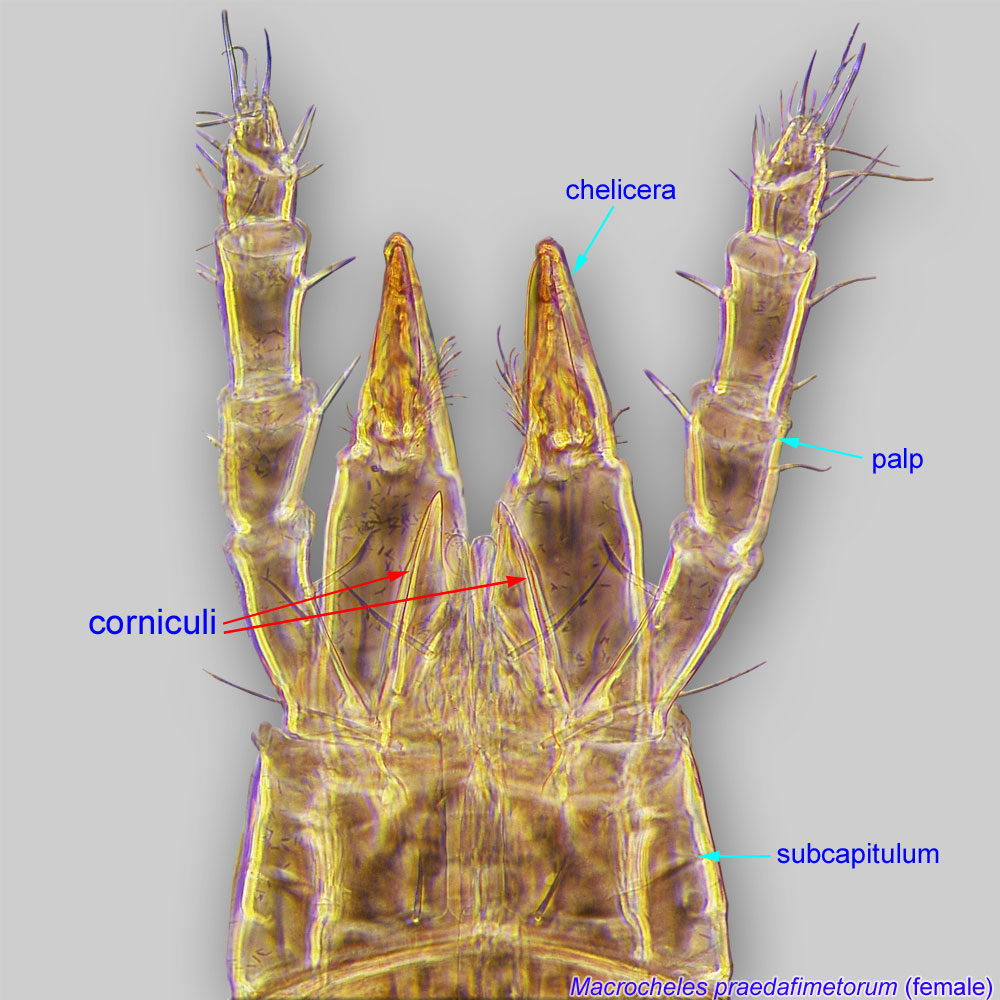may be harmful; consumes provisioned pollen in nest; phoreticphoretic:
Pertaining to phoresy; using another organism (i.e., a host) for dispersal to new habitats. Phoresy can be distinguished from parasitism because feeding typically does not occur during phoresy.
mites may be irritating
Afrocypholaelaps Elsen, 1972
Superorder Parasitiformes » Order Mesostigmata » Suborder Monogynaspida » Hyporder Dermanyssiae » Family Ameroseiidae » Genus Afrocypholaelaps
Neocypholaelaps africana Evans, 1963
Female: Dorsal shield not rugose (Figs. 1, 3, 6), with 29 pairs of setae (Fig. 3); setae j1 simplesimple:
Of claws or setae; not modified or not bi- or trifurcate at tip.
(Figs. 3, 6); setae J5 absent (Fig. 3). CorniculiCorniculus:
Paired, horn-like process (sometimes toothed, bifurcate, trifurcate, spine-like, spatulate, or membranous) on the subcapitulum of parasitiform mites. These processes usually support the salivary styli. If toothed could be confused with a rutellum, a possibly homologous structure in Acariformes and Opilioacarida.
 undivided, surrounded by transparent membrane (Fig. 8). All legs with well developed ambulacrumambulacrum:
undivided, surrounded by transparent membrane (Fig. 8). All legs with well developed ambulacrumambulacrum:
The claws and empodium of the apotele or pretarsus.
(Figs. 2, 9), claws reduced (Fig. 9). Spermathecal ducts (rami) fused above spermathecaspermatheca:
A structure in the female for storing sperm, typically sac-like.
(Fig. 10).
A dichotomous key is available in Ho et al., 2010Ho et al., 2010:
Ho, C.-C., L.-M. Ma, S.-C. Wang amp; L. L. Severinghaus. 2010. A new species and five new records of Ameroseiidae from Taiwan (Acari: Mesostigmata). Formosan Entomologist. 30: 167-176., but Afrocypholaelaps ewae was omitted. Note that Afrocypholaelaps dalyi Elsen, 1974 should be placed in the genus Hattena.
Similar to Hattena. Can be distinguished by the presence of 29 pairs of setae on the dorsal shield (25 or fewer pairs in Hattena) and by the fused spermathecal rami (separate in Hattena).
Tropics of the Old World and Oceania; includes Africa, Australia, Taiwan, Hawaii, and Saint Helena Island.
Mites of the genus Afrocypholaelaps live on various tropical flowers and use insect hosts merely as transport. Hence there is no specificity to a particular insect host. These mites are most common on European honey bee Apis mellifera (Afrocypholaelaps africana, A. analicullus). In addition, Afrocypholaelaps africana has been found on a variety of flower-visiting bees: Meliponula (a stingless bee), Ceratina (Apidae), Hylaeus pubescens (Colletidae), as well as wasps in the genus Chlorion (Sphecidae).
facultativefacultative:
can complete entire life cycle without bees or their close relative, wasps
Observations on feeding and phoreticphoretic:
Pertaining to phoresy; using another organism (i.e., a host) for dispersal to new habitats. Phoresy can be distinguished from parasitism because feeding typically does not occur during phoresy.
biology are available in Seeman and Walter, 1999Seeman and Walter, 1999:
Seeman, O. D. amp; D. E. Walter. 1995. Life history of Afrocypholaelaps africana (Evans) (Acari: Ameroseiidae), a mite inhabiting mangrove flowers and phoretic on honeybees. Journal of the Australian Entomological Society. 34: 45-50.. On the honey bee Apis mellifera, most Afrocypholaelaps africana mites occur at the base of the mouthparts on foraging bees, while on non-foraging bees they have been found on the mesosoma or metasoma. These bees, unlike foraging bees, attempted to remove the mites. Foraging bees may tolerate or be unaware of phoreticphoretic:
Pertaining to phoresy; using another organism (i.e., a host) for dispersal to new habitats. Phoresy can be distinguished from parasitism because feeding typically does not occur during phoresy.
mites, but attempt to groom the mites off when they return to the hive. Grooming may cause the mites to move to another position on the bee.
Plant hosts have not been extensively studied for Afrocypholaelaps, although Afrocypholaelaps africana has been found in very large numbers on flowers of the river mangrove Aegiceras corniculatum in Australia (Seeman and Walter, 1999Seeman and Walter, 1999:
Seeman, O. D. amp; D. E. Walter. 1995. Life history of Afrocypholaelaps africana (Evans) (Acari: Ameroseiidae), a mite inhabiting mangrove flowers and phoretic on honeybees. Journal of the Australian Entomological Society. 34: 45-50.).